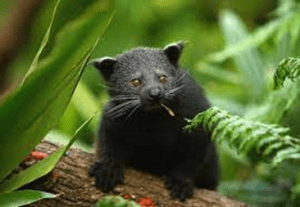TAG: GS 3: ECOLOGY AND ENVIRONMENT
THE CONTEXT: Kaziranga National Park and Tiger Reserve, nestled in the northeastern state of Assam, India, renowned for being the primary habitat of the one-horned rhinoceros, has recently witnessed a significant ecological development.
EXPLANATION:
- The discovery of two previously elusive mammalian species, the binturong and the small-clawed otter, adds to the rich tapestry of biodiversity in this UNESCO World Heritage Site.
Newcomers in the Wilderness: Binturong and Small-Clawed Otter
- Binturong (Arctictis binturong):
- Profile: The binturong, colloquially known as the bearcat, stands as the largest civet in India.
- Habitat and Rarity: Exhibiting nocturnal and arboreal habits, the binturong’s rarity is underscored by its uncommon distribution, primarily confined to the northeast in India.
- Distribution: Native to South and Southeast Asia, this arboreal mammal made a noteworthy appearance in Kaziranga during the fifth migratory bird count.

- Small-Clawed Otter (Aonyx cinereus):
- Characteristics: As the world’s smallest otter species, the small-clawed otter garnered attention after a training program conducted by the Wildlife Institute of India in collaboration with the Assam Forest Department.
- Geographical Presence: With a wide distribution from India to Southeast Asia and southern China, this otter is predominantly found in freshwater habitats.
- Hunting Prowess: Equipped with partially webbed feet and short claws, these otters exhibit adept hunting skills in aquatic environments, focusing on fish, crustaceans, and mollusks.

Conservation Significance: Wildlife Protection Act of 1972
- Legal Protection: Both the binturong and small-clawed otter find themselves listed under Schedule I of the Wildlife Protection Act of 1972, underscoring their critical status and the need for conservation efforts.
Documentation and Enumeration: Adding to the Mammalian Count
- Enumeration Efforts: The discovery of these mammals is credited to recent enumeration activities, revealing a total of 37 mammalian species in the 1,302 sq. km Kaziranga National Park and Tiger Reserve.
- Diverse Mammalian Community: The park boasts an impressive array of mammals, with the “Big Five” – the great Indian one-horned rhinoceros, Indian elephant, Bengal tiger, wild water buffalo, and eastern swamp deer – dominating the list.
Photographic Evidence: Capturing the Elusive
- Binturong Sighting: On January 10, the binturong made its presence known during the fifth migratory bird count, immortalized in a photograph taken by tour guide.
- Small-Clawed Otter Photography: Divisional Forest Officer captured the small-clawed otter on camera, showcasing the world’s smallest otter species in all its glory.
Educational Initiatives: Knowledge Sharing for Conservation
- The small-clawed otter’s documentation was a result of a training program conducted for officers and frontline staff by the Wildlife Institute of India in collaboration with the Assam Forest Department.
- These initiatives aim to enhance awareness and expertise among conservationists and wildlife officials, fostering a more informed approach to wildlife protection.
Geographical Spread and Beyond: The Habitat Context
- Distribution Range: While the binturong is native to South and Southeast Asia, the small-clawed otter’s habitat stretches from India to Southeast Asia and southern China.
- Previous Reports: Notably, the small-clawed otter was previously reported in the western Himalayas and parts of Odisha, though recent records indicate its absence in these regions.
Conclusion: A Tapestry of Life Unveiled
- Kaziranga National Park and Tiger Reserve, with its recent additions of the binturong and small-clawed otter, continues to be a beacon of biodiversity.
- The careful documentation, legal protections, and educational initiatives underscore the importance of preserving these habitats and fostering a harmonious coexistence between wildlife and human activities.
- The rich mammalian diversity stands as a testament to the ecological significance of this UNESCO World Heritage Site, inviting further exploration and conservation endeavors.

